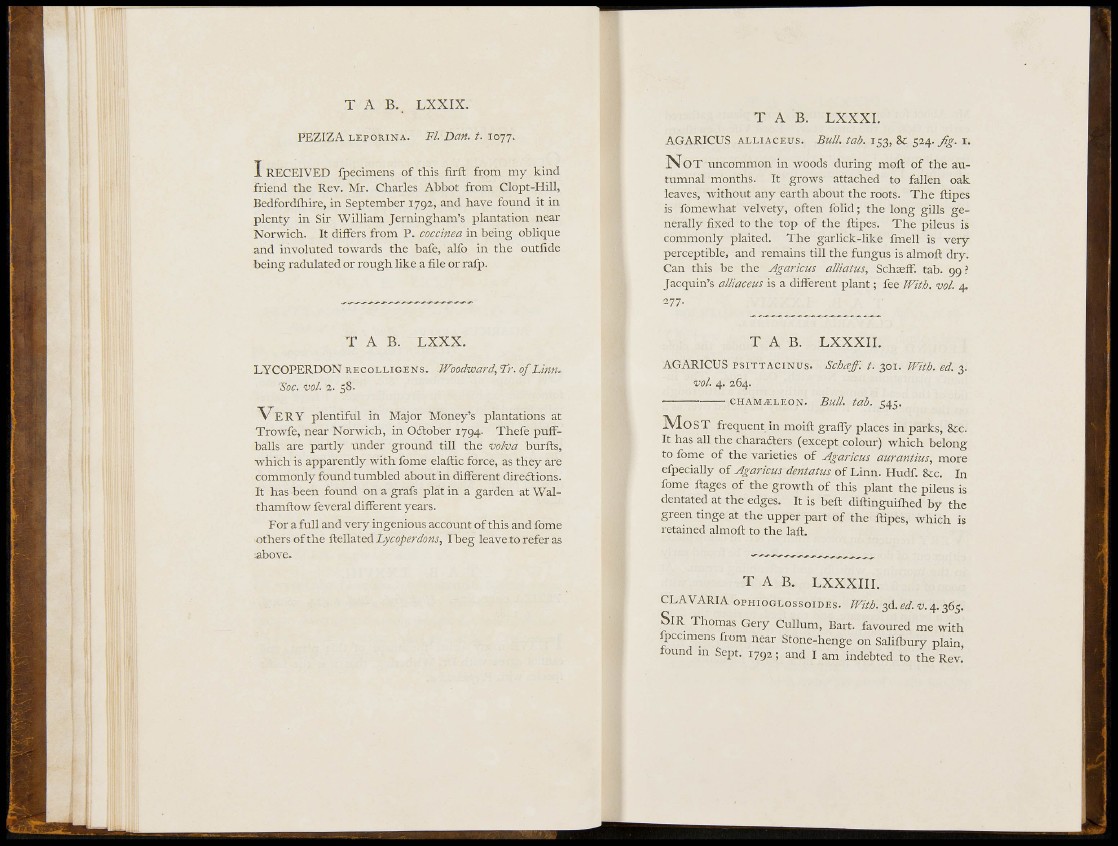
T A B . . LXXIX.
P E Z I Z A LEPORINA. FI Dan. t. 1077.
I RECEIVED fpecimens of this firft from my kind
friend the Rev. Mr. Charles Abbot from Clopt-Hill,
Bedfordihire, in September 1792, and have found it in
plenty in Sir William Jerningham's plantation near
Norwich. It differs from P. coccinea in being oblique
and involuted towards the bafe, aKb in the outfide
being radulated or rough like a file or rafp.
T A B. LXXX.
LYCOPERDON RECOLLIGENS. Woodward, Tr. of Linn.
Soc. vol. a. 58.
V E R Y plentiful in Major Money's plantations at
Trowfe, near Norwich, in Oftober 1794. Thefe puffballs
are partly under ground tiU the volva burfts,
which is apparently with fome elaftic force, as they are
commonly found tumbled about in different dire6tions.
It has been found on a grafs plat in a garden at Walthamftow
feveral different years.
For a full and very ingenious account of this and fome
others of the AeWzttidLLycoperdom, ITjeg leave to refer as
above.
T A B . LXXXI.
AGARICUS ALLIACEUS. Bull. tab. 153, &; 5 2 4 - i .
N O T uncommon in woods during moit of the autumnal
months. It grows attached to fallen oak
leaves, without any earth about the roots. The ñipes
is fomewhat velvety, often folid; the long gills generally
fixed to the top of the ñipes. The pileus is
commonly plaited. The garlick-like fmell is very
perceptible, and remains till the fungus is almoñ dry.
Can this be the Agaricus alliatus, Schaeff. tab. 99?
Jacquin's alUaceus is a different plant; fee With. vol. 4.
1TJ.
T A B . LXXXII.
AGARICUS PSITTACINUS. Schaff. t. 301. With. ed. 3.
vol. 4. 264.
CHAMELEON. Bull. tab. 545.
M O S T frequent in moiñ graffy places in parks, &cc.
It has all the charafters (except colour) which belong
to fome of the varieties of Agaricus aurantius, more
efpecially of Agaricus dentatus of Linn. Hudf. See. In
fome ñages of the growth of this plant the pileus is
dentated at the edges. It is beñ diñinguiflied by the
green tinge at the upper part of the ñipes, which is
retained almoñ to the lañ.
T A B . LXXXIII.
CLAVARIA OPHIOGLOSSOIDES. /nth. sd.ed. v. 4.365.
S IR Thomas Gery Cullum, Bart, favoured me with
fpeamens from near Stone-henge on Sahibury plain
found in Sept. 1792; and I am indebted to the Rev.